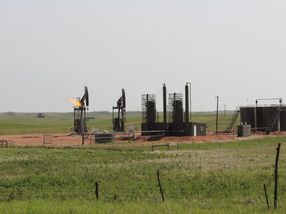Contamination in North Dakota linked to fracking spills
Metals, salts and radioactivity in brine-laden wastewater years later
Accidental wastewater spills from unconventional oil production in North Dakota have caused widespread water and soil contamination, a new Duke University study finds.

One of the 9,700 oil and gas wells drilled in North Dakota in the last decade. A Duke study has found wastewater spills are widespread, causing long-lasting contamination of soil and water.
Avner Vengosh

Duke graduate students Nancy Lauer and Jennifer Harkness conducting water and soil sampling at the Bear Den Bay spill site in North Dakota, where fracking wastewater was spilled.
Avner Vengosh


Researchers found high levels of ammonium, selenium, lead and other toxic contaminants as well as high salts in the brine-laden wastewater, which primarily comes from hydraulically fractured oil wells in the Bakken region of western North Dakota.
Streams polluted by the wastewater contained levels of contaminants that often exceeded federal guidelines for safe drinking water or aquatic health.
Soil at the spill sites was contaminated with radium, a naturally occurring radioactive element found in brines, which chemically attached to the soil after the spill water was released.
At one site, the researchers were still able to detect high levels of contaminants in spill water four years after the spill occurred.
"Until now, research in many regions of the nation has shown that contamination from fracking has been fairly sporadic and inconsistent," said Avner Vengosh, professor of geochemistry and water quality at Duke's Nicholas School of the Environment. "In North Dakota, however, we find it is widespread and persistent, with clear evidence of direct water contamination from fracking."
"The magnitude of oil drilling in North Dakota is overwhelming," Vengosh said. "More than 9,700 wells have been drilled there in the past decade. This massive development has led to more than 3,900 brine spills, mostly coming from faulty pipes built to transport fracked wells' flowback water from on-site holding containers to nearby injection wells where it will be disposed underground."
As part of the study, the team mapped the distribution of the 3,900 spill sites to show how they were associated with the intensity of the oil drilling.
North Dakota's unconventional oil production grew from about 100,000 barrels a day in 2007 to more than 1 million barrels a day in 2014. Much of the increased production has been made possible by advances in hydraulic fracturing and horizontal drilling. The industry's expansion in North Dakota has fueled economic growth, especially on tribal lands and in rural areas, but also has sparked concern about drinking water contamination.
"Unlike spilled oil, which starts to break down in soil, these spilled brines consist of inorganic chemicals, metals and salts that are resistant to biodegradation," said Nancy Lauer, a Ph.D. student of Vengosh's who was lead author of the study. "They don't go away; they stay. This has created a legacy of radioactivity at spill sites."
Soil samples collected downstream from spill sites contained higher levels of radioactivity than soil at the spill sites themselves, Lauer noted. This suggests that radium builds up in the soil as the spilled brine flows through the environment.
The Duke team published its peer-reviewed study today in the journal Environmental Science & Technology.
As part of their study, the researchers collected samples of brine-laden spill waters from four sites - two large spills and two smaller ones. They measured and analyzed the samples for inorganic contaminants and to identify the unique isotopic signature, or fingerprint, of Bakken region brines. By comparing this fingerprint to the geochemical and isotopic profiles of 29 background surface water samples collected across the region, the team was able to determine where and to what extent contamination associated with brine spills had occurred, and rule out the possibility that it had been caused by other sources.
"These isotopic tracers give scientists powerful forensic tools for tracking the presence of spill waters in the environment," Vengosh said. "Given that spills can occur upstream from drinking water sources, long-term monitoring of downstream waters is necessary to assess impacts on water quality."
One of the state's largest spills to date occurred in 2014, when an underground pipeline leak caused approximately 1 million gallons of brine to flow down a ravine and into Bear Den Bay, about a quarter mile upstream from a drinking water intake on Lake Sakakawea.
"Many smaller spills have also occurred on tribal lands, and as far as we know, no one is monitoring them," Vengosh added. "People who live on the reservations are being left to wonder how it might affect their land, water, health and way of life."





























































